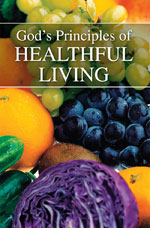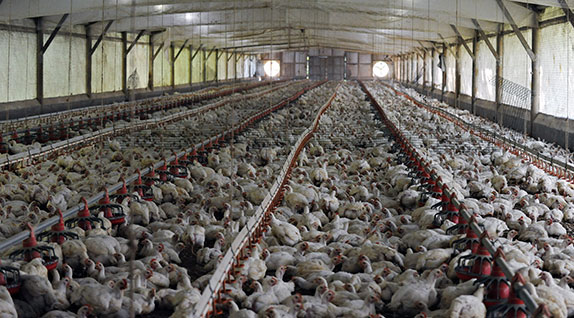 Elmer Martinez/AFP/Getty Images
Elmer Martinez/AFP/Getty Images
Article
Do you know how the food you eat is produced? The answer may surprise you.
Learn the why behind the headlines.
Subscribe to the Real Truth for FREE news and analysis.
Subscribe NowWhen shopping for groceries, have you ever thought about where the food you buy comes from—and how it is produced?
Many advertisements depict food as grown on small family farms. They picture cows grazing in pastures, chickens hopping around a barnyard, and farmers planting small acreages of crops such as corn, wheat, potatoes, soybeans and barley.
But the reality is quite different. Today’s cows are often bred in dirt feedlots, with the only grass seen outside the farm along the highway. Instead of wading through knee-high clover, cows are cloistered together and fed a noxious mix of additives to fatten them faster. In place of chickens picking at bugs on the ground or resting peacefully in a sunny, hay-strewn coup, are birds that gather around plastic tubing to peck at feed or are simply cage-bound their entire lives, with nothing but an area less than the size of a piece of paper on which to nest. Lush fields are instead pesticide-laden grounds, which do not possess nutritious soil for plants to develop necessary minerals and vitamins.
In fact, most of the food in supermarkets comes from large industrial operations—factory farms—that contain vast quantities of livestock or crops. These industrial farms, many of which are called AFOs (Animal Feeding Operations) and CAFOs (Concentrated Animal Feeding Operations), produce food in a manner drastically different from the past when most was grown by small, family-owned properties.
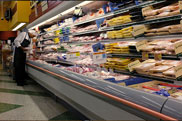 Joe Raedle/Getty Images
Joe Raedle/Getty Images
With more people moving from rural areas to cities, the concept of large-scale farming to feed a global population of more than seven billion people has become increasingly popular. More mouths require more food worldwide, which means that large quantities must be produced faster—and if possible, cheaper.
“Upton Sinclair’s The Jungle, written almost a century ago when the United States lacked many food-safety and labor regulations, described the appalling conditions of slaughterhouses in Chicago in the early 20th century and was a shocking expose of meat production and the conditions inflicted on both animals and humans by the industry,” research firm Worldwatch Institute reported in an article titled “Factory Farming in the Developing World.” “Workers were treated much like animals themselves, forced to labor long hours for very little pay under dangerous conditions, and with no job security.
“If The Jungle were written today, however, it might not be set in the American Midwest. Today, developing nations like the Philippines are becoming the centers of large-scale livestock production and processing to feed the world’s growing appetite for cheap meat and other animal products. But the problems Sinclair pointed to a century ago, including hazardous working conditions, unsanitary processing methods, and environmental contamination, still exist. Many have become even worse. And as environmental regulations in the European Union and the United States become stronger, large agribusinesses are moving their animal production operations to nations with less stringent enforcement of environmental laws.
“These intensive and environmentally destructive production methods are spreading all over the globe, to Mexico, India, the former Soviet Union, and most rapidly throughout Asia. Wherever they crop up, they create a web of related food safety, animal welfare, and environmental problems.”
Since most of our food comes from factory farms, it begs the question: is the food they produce just as healthy as if it had been grown naturally on a small farm?
Large-scale Agriculture
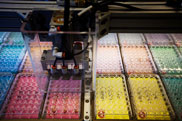 Brent Stirton/Getty Images
Brent Stirton/Getty Images
A factory farm produces huge volumes of food through industrial means. These food “factories” typically cover as many as several thousand acres. If it has livestock, it generally has several thousand animals confined in the same area. Because factory farms are so large, they achieve “economies of scale,” producing much more food at cheaper prices than smaller farms.
Often, these farms are owned by giant corporations and operate purely to gain profit, which maximizes benefits for their shareholders. Unlike small family farms, they usually do not have close connections to the communities in which they operate. Much of their produce is sold hundreds or even thousands of miles away.
In developed nations, factory farms have expanded rapidly since their origins in the early 20th century. Now only 3 percent of farms in the United States generate an astonishing 62 percent of its agricultural output! In fact, they have so consolidated the agricultural sector that only five food retailers (Kroger, Albertson’s, Wal-Mart, Safeway and Ahold USA) account for a whopping 42 percent of all retail food sales in the U.S.
“In the 1970s, the top five beef packers controlled only about 25 percent of the market,” investigative journalist Eric Schlosser stated in the documentary “Food, Inc.” “Today the top four control more than 80 percent of the market…You look at the labels and you see farmer this, farmer that. It is really just three or four companies controlling the meat. We’ve never had food companies this big and this powerful in our history.”
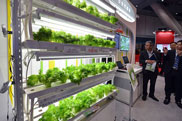 Yoshikazu Tsuno/AFP/Getty Images
Yoshikazu Tsuno/AFP/Getty Images
These industrial farms control all aspects of production, including animal rearing, feeding, slaughtering, packaging and distribution—a process known as “vertical integration.” While they often contract small farms to grow their produce or tend animals they supply, companies establish strict guidelines about how to grow crops and house livestock, as well as which seeds to use and what pesticides or antibiotics to apply during the process.
Because they are able to grow food cheaper, larger farms are forcing mid-size and small farms out of business. According to conservation agency American Farmland Trust (AFT), the most recent Census of Agriculture study demonstrated “a nationwide drop in land devoted to agricultural production from 922 million acres in 2007 to less than 915 million acres. This reduction continues a downward trend that has resulted in a 72 million acre decrease of land in agriculture since 1982.”
Good Business?
Because factory farms wield tremendous power, they have become a highly controversial topic, with many questioning whether they are beneficial for society and the environment as a whole. Those who support them point out that they provide multiple benefits.
• Cheap food production: Due to technology and economies of scale, factory farms can produce food at less cost than smaller farms, which enables customers to save money on food purchases.
• Efficiency: Large-scale farms have the ability to quickly produce and distribute huge quantities of food to sustain large cities.
A spokesperson for the National Chicken Council explained in “Food, Inc.”: “The chicken industry has really set a model for the integration of production and processing and marketing their products that other industries are now following because they see that we have achieved tremendous economies. In a way, we are not producing chickens, we are producing food. It’s all highly mechanized, so all the birds coming off those farms have to be almost exactly the same size. What the system of intensive production accomplishes is to produce a lot of food, in a small amount of land, at a very affordable price.”
• Employment: Factory farms provide employment to nearby communities and companies that use local people. In addition, supporters argue that they do invest in the communities in which they operate.
“In some countries, governments give tax breaks to companies that source locally, allowing them to pass on the lower cost to consumers,” Financial Times reported. “Price can be decisive in wooing low-income consumers to try branded products.”
Bad Results
On the other hand, opponents of factory farming contend that the negatives that come along with factory farming far outweigh the positives.
• Animal conditions: Typically, large numbers of animals are kept in close confinement on such farms, having little room to maneuver. This overcrowding frequently causes stress, frustration and joint pains. In addition, animals are given growth hormones to cause them to grow abnormally large in shorter periods of time, which often renders them unable to walk and greatly affects their quality of life.
• Diseases: Raising large numbers of animals in cramped conditions in which they are also slaughtered leads to disease. Many animals in feedlots are forced to stand in their own manure as there are minimal systems in place to dispose of it. Ammonia, the potent substance it exudes, can lead to blindness in chickens, or sickness in other animals.
The book Animal Factory stated: “Each dairy cow produces 120 pounds of wet manure a day—the equivalent of what twenty to forty people would generate. In a pasture-fed system, a farmer budgets up to 1.5 acres per cow. The land acts as a free-range toilet that can absorb the excrement. A confinement dairy does not have that option.”
According to Iowa’s Department of Natural Resources, this can result in unintended consequences: “Unlike livestock on pasture, animals in AFOs are kept in small areas where feed and manure become more concentrated. Animal manure and urine contain nitrogen (nitrate and ammonia), phosphorus, organic matter, sediments, pathogens, and heavy metals—all of which are potential pollutants if they are concentrated in a small area. Some of these substances can pose threats to human health or impair drinking water. When excess nutrients reach our waters, they can cause low levels of dissolved oxygen, algal blooms and, in extreme cases, fish kills.”
To ward off diseases, animals are injected with antibiotics, many of which are given to humans, which makes pathogens even more antibiotic resistant and causes humans to become sick.
Consider this editorial published in The New York Times: “If you walk into a farm-supply store today, you’re likely to find a bag of antibiotic powder that claims to boost the growth of poultry and livestock. That’s because decades of agricultural research has shown that antibiotics seem to flip a switch in young animals’ bodies, helping them pack on pounds. Manufacturers brag about the miraculous effects of feeding antibiotics to chicks and nursing calves. Dusty agricultural journals attest to the ways in which the drugs can act like a kind of superfood to produce cheap meat.
“But what if that meat is us? Recently, a group of medical investigators have begun to wonder whether antibiotics might cause the same growth promotion in humans. New evidence shows that America’s obesity epidemic may be connected to our high consumption of these drugs.”
Another popular additive that has resulted in problems is corn, a substance cows were never meant to eat.
Jean-Francois Monier/AFP/Getty Images
Contemporary feeding: A feeding robot automatically feeds Prim’Holstein dairy cows in Erbree, western France (Feb. 18, 2014).“So we feed corn to cattle,” Michael Pollan explained in the documentary “Food, Inc.” “And E coli, which is a very common bug evolves…And a strain called the E coli 0157H7 appears on the world stage. And it’s a product of the diet we’re feeding cattle on feedlots and it’s a product of feedlot life. The animals stand ankle deep in their manure all day long, so that if one cow has it, the other cows can get it. When they get to the slaughterhouse, their hides are caked with manure. And if the slaughterhouse is slaughtering 400 animals an hour, how do you keep that manure from getting on to those carcasses? And that is how the manure gets in the meat. And now this thing that wasn’t in the world, gets in the food system.”
The E coli-filled manure can then run into surrounding agricultural land, which causes contamination of crops, such as spinach and lettuce, and can result in death.
• Pollution: Factory farms produce large quantities of waste that is difficult to dispose of. This waste leaks into lakes, rivers and ground water, putting entire communities at risk.
“When manure is applied too frequently or in too large a quantity to an area, nutrients overwhelm the absorptive capacity of the soil, and either run off or are leached into the groundwater,” the U.S. Centers for Disease Control and Prevention stated in a publication about large-scale livestock operations. “Storage units can break or become faulty, or rainwater can cause holding lagoons to overflow. While CAFOs are required to have permits that limit the levels of manure discharge, handling the large amounts of manure inevitably causes accidental releases which have the ability to potentially impact humans…Emissions from degrading manure and livestock digestive processes produce air pollutants that often affect ambient air quality in communities surrounding CAFOs.”
• Monoculture: Factory farming typically devastates the ecosystem in an area by wiping out large tracts of land by producing one crop year after year.
“Industrially produced food appears to be inexpensive, but the price tag doesn’t reflect the actual costs that we taxpayers bear,” agricultural think tank Sustainable Table stated on their website. “Monocultures and factory farms pollute communities and adversely affect public health, thereby increasing medical costs for those living near such farms—costs that are often shouldered by public budgets. Taxpayers fund government subsidies which go primarily to large industrial farms. Jobs are lost and wages driven down as corporate consolidation bankrupts small businesses and factory farms pay unethically low wages for dangerous, undesirable work.”
• Inferior food: Food produced by factory farming has lower nutritional value than food produced by organic farming, which employs natural methods that help the Earth, rather than harm it. Organic food also contains higher levels of minerals, vitamins, antioxidants and nutrients.
A study published in the British Journal of Nutrition “…found substantially higher levels of antioxidants and lower levels of pesticides in organic fruits, vegetables and grains compared with conventionally grown produce,” The New York Times reported.
National Public Radio cited one instance in which farmers must routinely spray pesticides on tomatoes grown in nutrient-less beach sand in Florida—a state with a humid climate that attracts bugs—just to get them to grow.
“Florida applies more than eight times the amount of pesticide and herbicides as does California, the next leading tomato grower in the country. Part of this has to do with the fact that California processes tomatoes that are used for canning—and therefore don’t have to look as good as their Florida counterparts. But part of this also has to do with consumers.
“It’s the price we pay for insisting we have food out of season and not local,” Tomatoland author Barry Estabrook stated in the NPR article. “We foodies and people in the sustainable food movement chant these mantras, ‘local, seasonable, organic, fair-trade, sustainable,’ and they almost become meaningless because they’re said so often and you see them in so many places. If you strip all those away, they do mean something, and what they mean is that you end up with something like a Florida tomato in the winter—which is tasteless.”
Other Options?
A touted alternative to factory farming is “sustainable farming.” With this type of farming, crops are often grown organically (e.g., without synthetic pesticides) on smaller farms, routine crop rotation is practiced, and the produce is sold in the local communities. Animals are pasture-raised, well-treated and live in conditions that are suited to their normal behaviors.
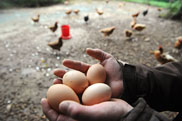 Remy Gabalda/AFP/Getty Images
Remy Gabalda/AFP/Getty Images
Supporters of sustainable farming claim it is more harmonious with the environment, and that the food produced is healthier and more nutritious.
Soil and agriculture expert Dale L. Schurter, author of Mounting Worldwide Crisis in Agriculture, stated that farmers should look to the insects and weeds that they are trying to destroy. Unknown to most, these “pests” are indicators of poor husbandry.
“Actually, they are guardians of soil, plant, animal and human health,” he said. “If we truly have eyes to see and ears to hear what they are telling us.”
In his book, he wrote: “Average farmers, ranchers, landscapers, horticulturists, lawn keepers, and home flower and vegetable gardeners continue to desperately look to chemical fertilizers, pesticides and herbicides—rather than to good husbandry practices that rebuild, restore and sustain true soil fertility, and crop, animal and human health. The Fertilizer Institute estimates that more than 50 million tons of chemical pesticides are being applied every year on food-producing land just in the United States of America, plus over 180 million are used on a combined much greater acreage in the rest of the world. It should be a ‘no brainer’ that 230 million TONS of poison (toxic chemicals) are incredibly harmful…This practice truly does support and promote other practices that kill and destroy. The costs are much higher than paying more for health-supporting, mineral-rich nontoxic foods.”
Later in the book, he admonishes agriculturists to find their roots and return to proven practices that have worked throughout time—that emphasize building up, rather than tearing down, man’s health and his environment.
“Man needs to change his attitude toward the soil. Instead of only taking from it, we need to give back to it by replacing and building up the supply of humus.
“Basically, this can be done through good management of cropping, tillage, fertilization and resting the land. Growing cover crops and returning other organic material such as crop residues, animal manures, etc., to the soil should be included—and we must stop poisoning it!
“We need to put technology to work to help us fertilize soil in a scientific, balanced way. Soil balancing through proper fertilization should be a major goal. Fertilization should not exceed the soil’s capacity to hold added nutrients on its colloidal system. To fertilize beyond this, remember, causes pollution problems, and wastes one’s hard-earned money.
“Based on the most recent estimates, every year, 1.37 billion tons of solid animal waste is produced, which ‘is 130 times greater than the amount of human waste—a total of [3.75] tons for every human being in the country’ (Pew Commission on Industrial Farm Animal Production). ‘Waste,’ however, is not the right word, for these byproducts of the life process should not be wasted but carefully used in maintaining soil fertility. Manure used to be carefully collected, composted and put on land. Today its disposal is one of the livestock industry’s biggest headaches. Instead of being a pollutant, as it has become in many instances, it should be considered an asset and returned to the soil.
“We need to make efficient use of all organic refuse. Why pollute our rivers and lakes with organic wastes when such material could be used to enrich the land?”
Two Ways
From a logical perspective, those who employ large farming practices are obviously doing something wrong. Consider. To yield the end results, they have to cut off cows’ tails—to keep them from swatting one another in a confined space—and chickens’ beaks—to keep them from pecking one another because they are overcrowded and lack trace minerals, which they then look for in the blood of fellow chickens.
These shortsighted tactics fail to correct the real causes of the problems. They are driven by greed and a lack of proper husbandry knowledge. Likewise, food crops grown by using enormous amounts of pesticides to kill bugs and weeds is detrimental to the soil. Animals and crops raised in such conditions of duress will naturally not do well—as evidenced by the decreased amount of nutrients they each produce.
Yet there is more to it than just what it does to people’s health and the environment. The concept of a large farm is not in and of itself wrong, but the methods employed by those who operate them go against preset laws of nature that were designed to provide healthy, happy, abundant lives for everyone in society.
When crops and animals are healthier, better food is produced. After all, that is why they were created! Otherwise, everyone would end up sick—which is exactly what is routinely seen now.
The difference between the two ways of farming that have been presented represent two basic ways of life: the way of give and the way of get. The way of give is the way of outflowing love. It is based on what is best for others, helping and serving them, and looking out for their best interests.
On the other hand, the way of get is based on selfishness. It is not concerned with what is best for others.
You may be surprised that agriculture is extensively discussed in the Bible through God’s laws, statutes and principles, which regulate the care of animals, agriculture, property and ultimately one’s concern for his fellow man. In addition, it also shows how man should live, including principles of healthful living that were designed to help him achieve an abundant life full of joy and happiness. To learn about these, read God’s Principles of Healthful Living.
God’s Way is to produce food that is nutritious for others while simultaneously keeping the environment healthy. It shows love and kindness to mankind and animals alike. It is not the “profit at all cost” approach.
Man’s greed in placing profit above all else has resulted in environmental damage, sickness and disease, and in the production of inferior food that weakens rather than strengthens the body.
“Today’s farmlands are tired, overworked and being depleted,” Mr. Schurter wrote in his book. “In man’s husbandry of the soil, his impulse is to take the simple, fast, cheap, easy way—either ignoring or not recognizing the real causes of the problem. Too often, agriculturists see only the effects, while the actual causes of the crisis grow worse and more complicated.
“If we are to preserve the well-being of the soil for our sake, and for the sake of our children, and children’s children, a major reform in modern agriculture is a must. We must recognize our agricultural problems—their causes—and correct them.”
There is a way to do this, but it is not the easy route most follow. It involves respecting the natural processes that God established from the creation of the Earth. This is the only way to stop the cycle of greed leading to poor husbandry and agriculture practices, which in turn leads to depleted food, compromised immune systems, and widespread disease and misery—for animals and humans alike.
It can be done. But we must realize that we are wrong, and take steps to make it happen.

